Lost Era
San Francisco

San Francisco (ST-06)

San Francisco (VOY-122)

San Francisco (ENT-01-02)

San Francisco (ENT-01-02)

Starfleet Communications (VOY-230)

San Francisco, 1893 (TNG-226)

San Francisco, 1893 (TNG-227)
Located in California on Earth. Many key Starfleet facilities were located within the city, including Starfleet Academy[3] and Starfleet Command,[2], as well as the offices of the San Francisco Fleet Yards.[1] Jonathan Archer was raised in San Francisco.[6]
Lieutenant Commander Data was transported from Devidia II in 2368 to San Francisco in 1893 while pursuing a group of Devidians who were traveling through time.[4] Cholera had broken out in the city at this time, and the Devidians were using it as to cover up the fact that they were harvesting Human neural energy as a food source. Guinan and Samuel “Mark Twain” Clemens lived in San Francisco in 1893, and they encountered Data and Jean-Luc Picard, who had followed Data back in time.[5]
References
Pluto
A Class-C planetoid,[1] Pluto alternated between being considered a planet and a planetoid ever since its discovery in the mid-20th century:[5] in 1996, Pluto was depicted as the ninth planet in the Sol System on a poster in Rain Robinson‘s office at Griffith Observatory;[3] in 2367, the U.S.S. Enterprise NCC-1701‘s computers showed a map to Nomad, depicting Pluto as the ninth planet in the system.[1] In 2292, the maiden voyage of the U.S.S. Enterprise NCC-1701-B was planned as “a quick run around the block,” taking the ship from Earth, out past Pluto, then back to the inner system; a distress call from the S.S. Lakul, however, necessitated a change of plans.[2] Pluto had a diameter of 2300 kilometers, a surface temperature of -236°C, a rotation of 6390 days, and gravity of 0.07 g. Located 5.9 billion kilometers from Sol, it took 248.5 Earth years to complete one orbit. Pluto had one moon, Charon, which was nearly as large as Pluto itself.[4] In the EU timeline, Pluto was destroyed during a Borg invasion of the Sol System in 2381.[5]
References
Luna
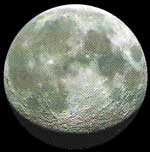
Luna (STSC)
Luna, commonly known simply as “the Moon,” was a Class-D world orbiting Earth.[4] By the late 24th century, more than 50 million people lived on the Moon.[3] The Talosians viewed several images about Earth’s Moon and programs to study and explore it while accessing the U.S.S. Enterprise NCC-1701‘s computer in 2254.[1] The Copernicus Ship Yards were located in orbit, with office facilities on the surface; the U.S.S. Hathaway NCC-2593 was built there.[2] Other points of interest on the Moon included Tranquility Base, where Apollo 11 landed in July 1969; as well as Lake Armstrong and New Berlin.[3] See also: Apollo program, Armstrong, Neil, Kennedy, John F., Lunar probe, Ranger probe.
References
Earth
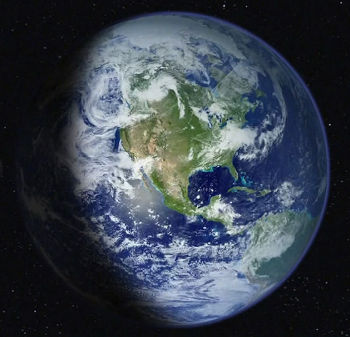
Earth (TOS-21)

Earth (ENT-78)
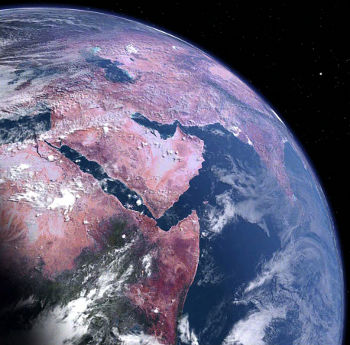
Earth (TOS-55)
Class-M. Earth is the third planet in the Sol System[1] in Sector 001[7] and homeworld of Humans. In 2254, the Talosians viewed an image of the Sol System and many images of Earth’s history while accessing the U.S.S. Enterprise NCC-1701‘s computer.[1] Earth became one of the founding members of the United Federation of Planets in 2161,[15] following the Romulan War,[6] and served as that body’s capital.[5] Starfleet Command and Starfleet Academy were based in San Francisco,[2, 3] while the offices of the Federation President[9] and the Federation Council chamber were located in Paris.[22] The planet hosted several advanced orbital habitats,[2] Starfleet spacedocks,[4] and satellite networks, including Federation communications networks.[12]
› Continue reading
Deep Space Nine
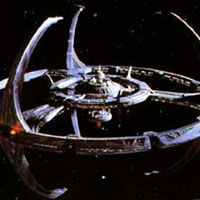
Deep Space Nine (DS9-401-402)
Formerly a Cardassian mining facility orbiting Bajor called Terok Nor, the station was redesignated Deep Space Nine when it came under Federation control following the end of the Cardassian Occupation of Bajor in 2369. At the behest of the Bajoran Provisional Government, Starfleet administered the facility. Shortly after the arrival of the station’s new Starfleet crew, however, a stable, artificial wormhole was discovered in the Bajor System‘s Denorios Belt. The station was moved to a new position near the terminus of the wormhole, and it quickly became a focal point for political and military intrigue, as well as one of the most strategic locations in the quadrant.[1]
References
- 1. “Emissary.” Star Trek: Deep Space Nine, Episodes 401-402. Television. 4 January 1993.
Planet, Class-M

Earth (ENT-78)
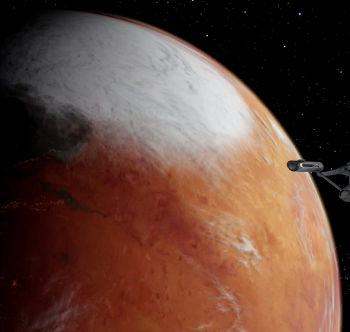
Vulcan (TOS-34)
Terrestrial. Age ranged from 3-10 billion years. Diameter was 10,000 to 15,000 km. Typically located in the Ecosphere of a planetary system. Surface water was abundant; if water or ice covered more than 80% of the surface, the planet was considered Class O or Class P. Atmosphere was primarily primarily nitrogen, oxygen, and trace elements. Contained extensive vegitation and animal life.[8] Capable of supporting carbon-based, humanoid life.[1]
The designation apparently stemmed from the Vulcan word “Minshara,” which was used to designate planets capable of supporting life.[7] Class-M planets could vary widely in color, cloud cover, and overall appearance. Most Class-M planets were characterized by a relatively thin, tectonically active crust floating on a molten rock mantle, which in turn surrounded a liquid metal outer core and a solid inner core composed of metal crystals.
› Continue reading
Planet, Class-J
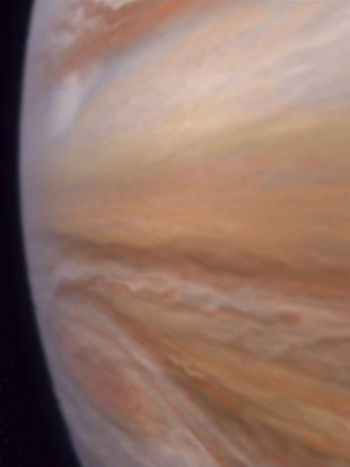
Jupiter (ENT-50)
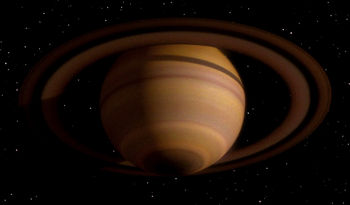
Saturn (TNG-101-102)
Gas giant. Age ranges from 2-10 billion years. Diameter is 50,000 to 140,000 km. Typically located in the Cold Zone of a planetary system. Surface radiates some heat and is tenuous and comprised of gaseous hydrogen and hydrogen compounds, atmospheric zones vary in temperature, pressure and composition. May contain hydrocarbon-based life forms.[1]
References
- 1. Star Trek Star Charts. Book. Pocket Books. October 2002.
Quadrants

One quarter of the galaxy. The four quadrants were designated by the Greek letters Alpha, Beta, Gamma, and Delta, and were arbitrarily divided using Earth as a reference point. As a result, Earth, and the sector it occupied, fell in the Alpha Quadrant, while the sector containing Vulcan and Andoria fell in the Beta Quadrant. The Gamma and Delta Quadrants remained largely unexplored through the 25th century, though knowledge of those regions was greatly increased thanks to the Bajoran wormhole and the U.S.S. Voyager NCC-74656, respectively.[1]
› Continue reading
Milky Way Galaxy

Milky Way (TOS-01)
The Milky Way was a spiral galaxy approximately 100 thousand light years across, divided into four quadrants, designated by the Greek letters Alpha, Beta, Gamma, and Delta, and were arbitrarily divided using Earth as a reference point. As a result, Earth, and the Sol Sector, fell in the Alpha Quadrant, while the Vulcan and Andorian Sectors fell in the Beta Quadrant. The Gamma and Delta Quadrants remained largely unexplored by the early 25th century, though knowledge of those regions was greatly increased thanks to the Bajoran wormhole and the U.S.S. Voyager NCC-74656, respectively.[3] The galaxy was surrounded by a nearly-impenetrable energy field, dubbed the Galactic Barrier, with unpredictable neurogenic properties.[1, 3] Likewise, the core of the galaxy is surrounded by a distinct but related field, dubbed the Great Barrier.[2, 3]
› Continue reading
Betreka Nebula
Though the details were not specified, an incident there between the Klingons and Cardassians led to hostilities between the two empires for 18 years.[1]
References
- [1]DS9-473-474: The Way of the Warrior
Categories
- Animated Series (60)
- Articles (28)
- Books (447)
- Cast & Crew (79)
- Comics (22)
- DS9 (328)
- Early Voyages (125)
- Education (5)
- Enterprise (373)
- Excelsior (36)
- Food (19)
- Games (223)
- Klingon (70)
- Library (1,543)
- Logs (593)
- Lost Era (55)
- Medicine (18)
- Merrimac (1)
- Mirror (35)
- Miscellaneous (13)
- New Frontier (54)
- Next Generation (635)
- Original Series (681)
- Personnel (436)
- Places (369)
- Politics (12)
- Recreation (10)
- SCE (41)
- Science (1)
- Shatnerverse (9)
- Ships (455)
- Site Updates (98)
- Starfleet Academy (86)
- Stargazer (42)
- STO (61)
- Technology (45)
- Titan (59)
- To Boldly Go (1)
- TV/Film (214)
- Uncategorized (4)
- Vanguard (76)
- Voyager (236)
- Weapons (27)
- Xenology (54)